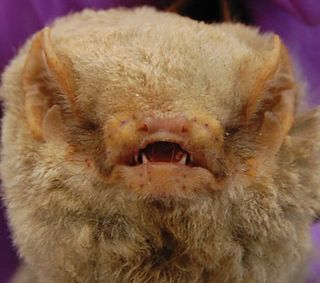
Vespertilionidae is a family of microbats, of the order Chiroptera, flying, insect-eating mammals variously described as the common, vesper, or simple nosed bats. The vespertilionid family is the most diverse and widely distributed of bat families, specialised in many forms to occupy a range of habitats and ecological circumstances, and it is frequently observed or the subject of research. The facial features of the species are often simple, as they mainly rely on vocally emitted echolocation. The tails of the species are enclosed by the lower flight membranes between the legs. Over 300 species are distributed all over the world, on every continent except Antarctica. It owes its name to the genus Vespertilio, which takes its name from a word for bat, vespertilio, derived from the Latin term vesper meaning 'evening'; they are termed as evening bats and once referred to as 'evening birds'.
The little pied bat is a species of vesper bat in the family Vespertilionidae. It is found only in semi-arid woodlands in eastern Australia.

Allen's striped bat is a species of bat in the family Vespertilionidae, the vesper bats. It is native to Africa, where it occurs in Cameroon and the Democratic Republic of the Congo. This species can be found in lowland tropical moist forests. Little else is known about it.

The silvered bat is a species of vesper bat in the family Vespertilionidae. It is found in Angola, Burundi, Cameroon, Republic of the Congo, Democratic Republic of the Congo, Equatorial Guinea, Kenya, Malawi, Rwanda, and Tanzania. Its natural habitats are subtropical or tropical moist lowland forests and moist savanna.

Beatrix's bat is a species of vesper bat in the family Vespertilionidae. It can be found in the following countries: Angola, Central African Republic, Democratic Republic of the Congo, Ivory Coast, Equatorial Guinea, Gabon, Ghana, Kenya, and Nigeria. It is found in these habitats: subtropical or tropical moist lowland forests. It is threatened by habitat loss.
The Bibundi bat is a species of vesper bat in the family Vespertilionidae. It can be found in the following countries: Cameroon, Republic of the Congo, and Uganda. It is also found in Dzanga-Sangha Special Reserve.
Glen's wattled bat is a species of vesper bat in the family Vespertilionidae. It is found in Cameroon and Uganda. Its natural habitat is subtropical or tropical moist lowland forests. It is threatened by habitat loss.

The Abo bat is a species of vesper bat in the family Vespertilionidae. It is found in several countries in West Africa and Central Africa. It is found in these habitats: subtropical or tropical dry forest and subtropical or tropical moist lowland forest.
Curry's bat is a species of vesper bat in the family Vespertilionidae. It is found in Cameroon and Democratic Republic of the Congo. Its natural habitats are subtropical or tropical moist lowland forests and subtropical or tropical swamps.

Allen's spotted bat is a species of vesper bat in the family Vespertilionidae found in the following countries: the Central African Republic, the Democratic Republic of the Congo, Kenya, and Uganda. It is found in subtropical or tropical moist lowland forests.
Machado's butterfly bat is a species of vesper bat in the family Vespertilionidae. It is found only in Angola. Its natural habitat is subtropical or tropical moist lowland forests.

Schreber's yellow bat or the giant house bat, is a species of vesper bat. It is found in Benin, Democratic Republic of the Congo, Ivory Coast, Ghana, Kenya, Malawi, Mozambique, Nigeria, Senegal, Tanzania, Togo, and Zimbabwe. Its natural habitats are subtropical or tropical moist lowland forests, dry savanna, and moist savanna. It is an uncommon species and its biology is poorly known. It was first described in 1774 by the German naturalist Johann Christian Daniel von Schreber, who named it Vespertilio nigrita. It was later transferred to the genus Scotophilus, making it Scotophilus nigrita.
The broad-headed pipistrelle is a species of vesper bat in the family Vespertilionidae. It is found in Angola, Cameroon, Republic of the Congo, Democratic Republic of the Congo, Ivory Coast, Guinea, liberia, Kenya, South Sudan, and Uganda. Its natural habitats are subtropical or tropical dry forest, subtropical or tropical moist lowland forest, and subtropical or tropical moist montane forest.
Eisentraut's pipistrelle is a species of vesper bat in the family Vespertilionidae. It is found in Cameroon, Democratic Republic of the Congo, Kenya, Somalia, and Uganda. Its natural habitats are subtropical or tropical dry forest, subtropical or tropical moist lowland forest, subtropical or tropical mangrove forest, and subtropical or tropical moist montane forest.
The lesser long-fingered bat, also known as the black clinging bat or lesser bent-winged bat, is a species of vesper bat in the family Vespertilionidae.

The Aba roundleaf bat, also known as the Aba leaf-nosed bat is a species of bat in the family Hipposideridae. It is found in west Africa along the southern coast from Nigeria to Senegal. Populations have also been noted in Sudan and Uganda. Its natural habitats are subtropical or tropical moist lowland forests, dry savanna, moist savanna, and caves.

The African giant free-tailed bat, or African free-tailed bat is a species of bat in the family Molossidae. It is found in Democratic Republic of the Congo, Eritrea, Ethiopia, Kenya, Malawi, Mozambique, South Sudan, Tanzania, Zambia, Zimbabwe, and possibly South Africa. Its natural habitats are dry savanna and subtropical or tropical dry shrubland.

The striped leaf-nosed bat is a species of bat native to eastern and southern Africa. It was formerly considered part of M. commersoni, which is now viewed as being restricted to Madagascar. Both commersoni and it were formerly placed in the genus Hipposideros, but moved to the resurrected Macronycteris in 2017 on the basis of molecular evidence.












